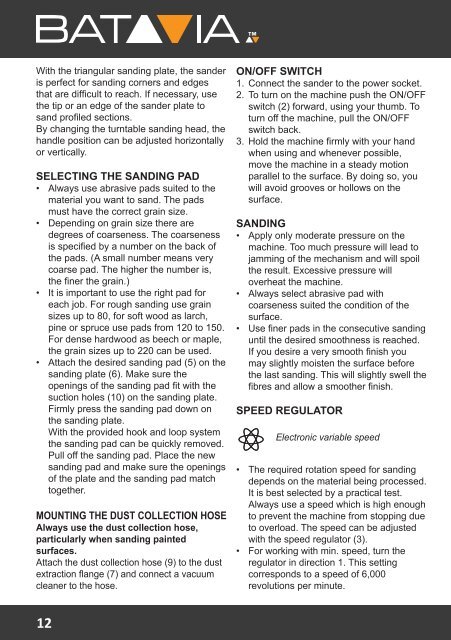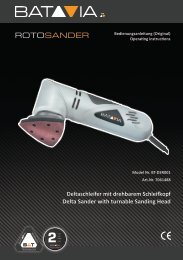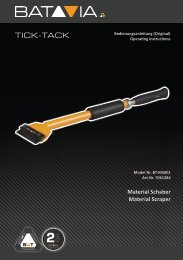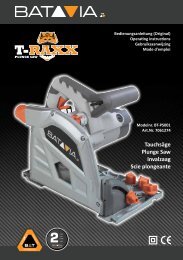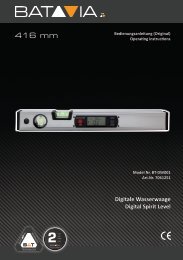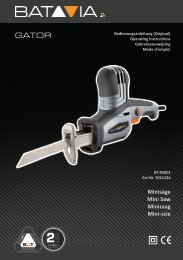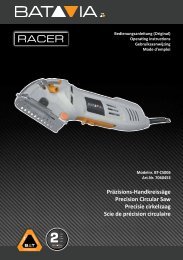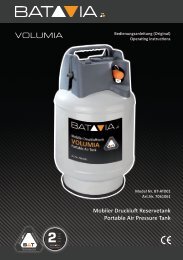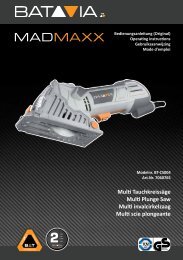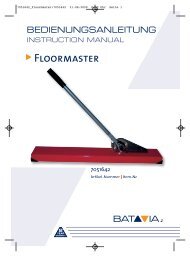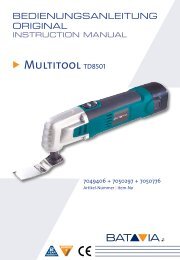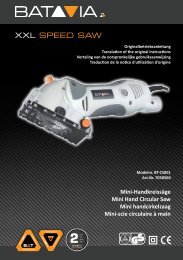Bedienungsanleitung Rotosander - Deltaschleifer mit drehbaren Schleifkopf
Sie wollen auch ein ePaper? Erhöhen Sie die Reichweite Ihrer Titel.
YUMPU macht aus Druck-PDFs automatisch weboptimierte ePaper, die Google liebt.
TM<br />
With the triangular sanding plate, the sander<br />
is perfect for sanding corners and edges<br />
that are difficult to reach. If necessary, use<br />
the tip or an edge of the sander plate to<br />
sand profiled sections.<br />
By changing the turntable sanding head, the<br />
handle position can be adjusted horizontally<br />
or vertically.<br />
SELECTING THE SANDING PAD<br />
• Always use abrasive pads suited to the<br />
material you want to sand. The pads<br />
must have the correct grain size.<br />
• Depending on grain size there are<br />
degrees of coarseness. The coarseness<br />
is specified by a number on the back of<br />
the pads. (A small number means very<br />
coarse pad. The higher the number is,<br />
the finer the grain.)<br />
• It is important to use the right pad for<br />
each job. For rough sanding use grain<br />
sizes up to 80, for soft wood as larch,<br />
pine or spruce use pads from 120 to 150.<br />
For dense hardwood as beech or maple,<br />
the grain sizes up to 220 can be used.<br />
• Attach the desired sanding pad (5) on the<br />
sanding plate (6). Make sure the<br />
openings of the sanding pad fit with the<br />
suction holes (10) on the sanding plate.<br />
Firmly press the sanding pad down on<br />
the sanding plate.<br />
With the provided hook and loop system<br />
the sanding pad can be quickly removed.<br />
Pull off the sanding pad. Place the new<br />
sanding pad and make sure the openings<br />
of the plate and the sanding pad match<br />
together.<br />
MOUNTING THE DUST COLLECTION HOSE<br />
Always use the dust collection hose,<br />
particularly when sanding painted<br />
surfaces.<br />
Attach the dust collection hose (9) to the dust<br />
extraction flange (7) and connect a vacuum<br />
cleaner to the hose.<br />
ON/OFF SWITCH<br />
1. Connect the sander to the power socket.<br />
2. To turn on the machine push the ON/OFF<br />
switch (2) forward, using your thumb. To<br />
turn off the machine, pull the ON/OFF<br />
switch back.<br />
3. Hold the machine firmly with your hand<br />
when using and whenever possible,<br />
move the machine in a steady motion<br />
parallel to the surface. By doing so, you<br />
will avoid grooves or hollows on the<br />
surface.<br />
SANDING<br />
• Apply only moderate pressure on the<br />
machine. Too much pressure will lead to<br />
jamming of the mechanism and will spoil<br />
the result. Excessive pressure will<br />
overheat the machine.<br />
• Always select abrasive pad with<br />
coarseness suited the condition of the<br />
surface.<br />
• Use finer pads in the consecutive sanding<br />
until the desired smoothness is reached.<br />
If you desire a very smooth finish you<br />
may slightly moisten the surface before<br />
the last sanding. This will slightly swell the<br />
fibres and allow a smoother finish.<br />
SPEED REGULATOR<br />
<br />
Electronic variable speed<br />
• The required rotation speed for sanding<br />
depends on the material being processed.<br />
It is best selected by a practical test.<br />
Always use a speed which is high enough<br />
to prevent the machine from stopping due<br />
to overload. The speed can be adjusted<br />
with the speed regulator (3).<br />
• For working with min. speed, turn the<br />
regulator in direction 1. This setting<br />
corresponds to a speed of 6,000<br />
revolutions per minute.<br />
12<br />
7061488 Ma # 1208-14.indd 12 14-08-12 08:44


